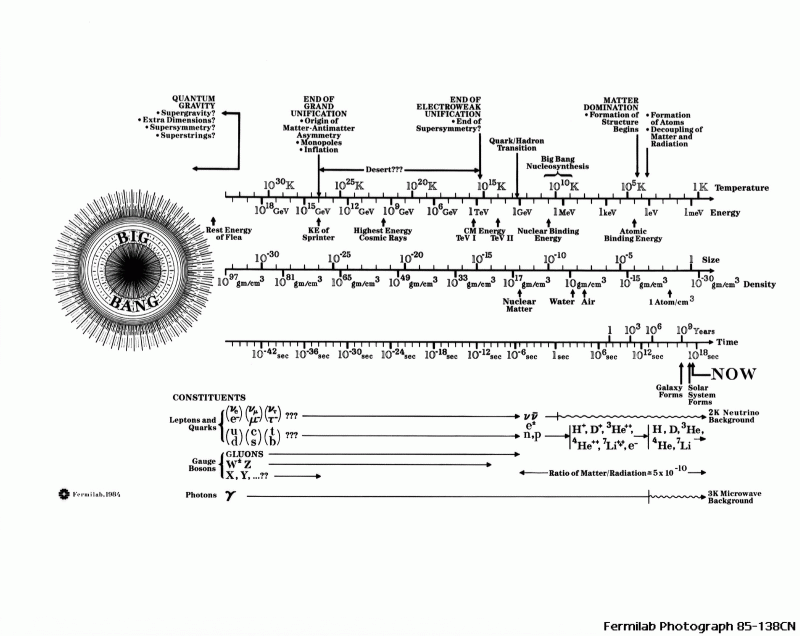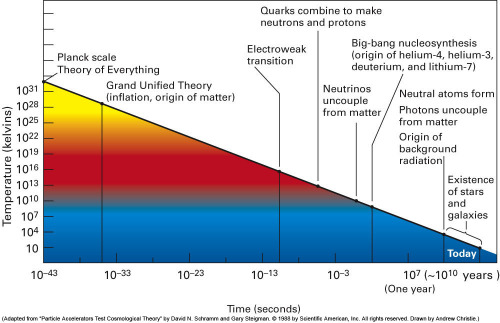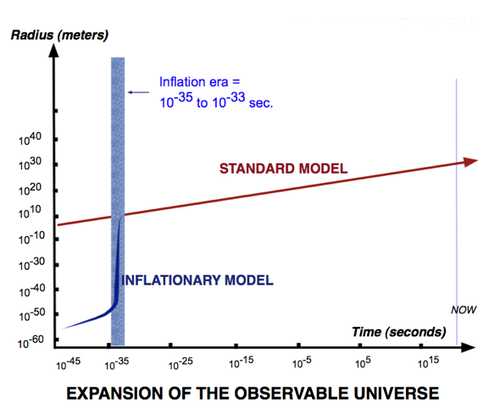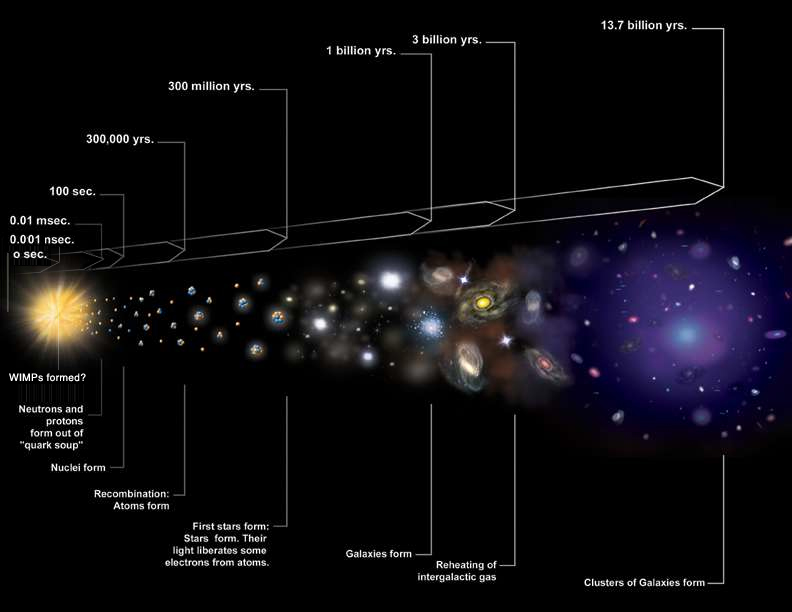
Universe
| Palaeos: |  |
The Primordial Era |
| Cosmos | The Very Early Universe |
| Page Back | Unit Up: Cosmos home | Unit home | Glossary | Page Next: |
| Unit Back: Cosmic Timescale | Page Down (none) | Unit Down (none) | References | Unit Next: The Stelliferous Era |

Fermi Lab's History of the Universe Timeline from 1985 - posted by Bill Gusky, Art Blog Comments
When it comes to Big Bang cosmology, there isn't really any difference between higher energy physics and physical cosmology, both are based on extreme temperatures and pressures and infinitesimal periods of time. They use such large numbers that they can only be mapped logarithmically. The above diagram, from Fermi Labs, illustrates the convergence of the quantum physical and the cosmological, and can serve as the foundation for the "phylogeny of matter"
All ideas concerning the very early universe (cosmogony) are speculative. As of early 2010, no accelerator experiments probe energies of sufficient magnitude to provide any experimental insight into the behavior of matter at the energy levels that prevailed during this period. Proposed scenarios differ radically. Some examples are the Hartle-Hawking initial state, string landscape, brane inflation, string gas cosmology, and the ekpyrotic universe. Some of these are mutually compatible, while others are not. - Wikipedia

The early stages of the universe were defined in terms of unimaginable temperatures and infinitesimal moments in time. As the cosmos expanded, it cooled, giving rise to the present universe. The events in this page are mostly pertain to the far left of the diagram. MAK110718. Graphic from A Brief History of the Universe |
At the energy levels that prevailed during the Planck epoch the four fundamental forces—electromagnetism, gravitation, weak nuclear interaction, and strong nuclear interaction—may all have the same strength, so they are possibly unified in one fundamental force. Little is known about this epoch, and different theories propose different scenarios. General relativity predicts a gravitational singularity before this time, but under these conditions the theory is expected to break down due to quantum effects. Physicists hope that proposed theories of quantum gravitation, such as string theory, loop quantum gravity, and causal sets, will eventually lead to a better understanding of this epoch. - Wikipedia
As the universe expands and cools from the Planck epoch, gravitation begins to separate from the fundamental gauge interactions: electromagnetism and the strong and weak nuclear forces. Physics at this scale may be described by a grand unified theory in which the gauge group of the Standard Model is embedded in a much larger group, which is broken to produce the observed forces of nature. Eventually, the grand unification is broken as the strong nuclear force separates from the electroweak force. This occurs as soon as inflation does. According to some theories, this should produce magnetic monopoles. - Wikipedia
The temperature of the universe is low enough (1028 K) to separate the strong force from the electroweak force (the name for the unified forces of electromagnetism and the weak interaction). This phase transition triggers a period of exponential expansion known as cosmic inflation. After inflation ends, particle interactions are still energetic enough to create large numbers of exotic particles, including W and Z bosons and Higgs bosons. - Wikipedia

The inflationary epoch. From What are the odds? Part 2: Cosmic Inflation! by Ethan Siegel |
The temperature, and therefore the time, at which cosmic inflation occurs is not known for certain. During inflation, the universe is flattened (its spatial curvature reaches the so called critical value) and the universe enters a homogeneous and isotropic rapidly expanding phase in which the seeds of structure formation are laid down in the form of a primordial spectrum of nearly scale-invariant fluctuations. Some energy from photons becomes virtual quarks and hyperons, but these particles decay quickly. One scenario suggests that prior to cosmic inflation, the universe was cold and empty, and the immense heat and energy associated with the early stages of the big bang was created through the phase change associated with the end of inflation.
According to the ΛCDM (Lambda-Cold Dark Matter) model, dark energy is present as a property of space itself, beginning immediately following the period of inflation, as described by the equation of state (cosmology). ΛCDM says nothing about the fundamental physical origin of dark energy but it represents the energy density of a flat universe. Observations indicate that it has existed for at least 9 billion years. - Wikipedia
But as Ethan Siegel points out, there is one important implication inherent in Inflation that is not taken into account by the numerous accounts of the Big Bang (and diagrams based thereon). To quote:
"...unlike Supersymmetry at the LHC, I think that there's about a 98% chance that inflation is correct. This also means that every single image you see that places the Big Bang before inflation in the cosmic timeline is not only wrong, but dishonest. Why? Because we have no idea what happened prior to inflation, and by the very nature of inflation, we can't. That's as far back as physics allows us to go, at least, right now.
So to recap, inflation is the thing that happens that sets up the Big Bang. Based on what we've seen, it stretches the Universe flat, makes it the same temperature in all directions, gets rid of any junk that was lying around beforehand, and creates the proper fluctuations on all scales -- small and large -- to grow into the stars, galaxies, and clusters that we have at present.
Again quoting Wikipedia:
"The ekpyrotic universe, or ekpyrotic scenario, is a cosmological model of the origin and shape of the universe. The name comes from a Stoic term ekpyrosis meaning conflagration or in Stoic usage "conversion into fire".[1] The ekpyrotic model of the universe is an alternative to the standard cosmic inflation model for the very early universe; both models accommodate the standard big bang Lambda-CDM model of our universe. The ekpyrotic model is a precursor to, and part of some cyclic models.
The ekpyrotic model came out of work by Neil Turok and Paul Steinhardt and maintains that the universe did not start in a singularity, but came about from the collision of two branes. This collision avoids the primordial singularity and superluminal expansion while preserving nearly scale-free density fluctuations and other features of the observed universe. The ekpyrotic model is cyclic, though collisions between branes are rare on the time scale of the expansion of the universe to a nearly featureless flat expanse. Observations that may distinguish between the ekpyrotic and inflationary models include polarization of the cosmic microwave background radiation and frequency distribution of the gravitational wave spectrum." (Khoury et al 2001, Steinhardt & Turok 2002) - Wikipedia
During reheating, the exponential expansion that occurred during inflation ceases and the potential energy of the inflaton field decays into a hot, relativistic plasma of particles. If grand unification is a feature of our universe, then cosmic inflation must occur during or after the grand unification symmetry is broken, otherwise magnetic monopoles would be seen in the visible universe. At this point, the universe is dominated by radiation; quarks, electrons and neutrinos form. - Wikipedia
There is currently insufficient observational evidence to explain why the universe contains far more baryons than antibaryons. A candidate explanation for this phenomenon must allow the Sakharov conditions to be satisfied at some time after the end of cosmological inflation. While particle physics suggests asymmetries under which these conditions are met, these asymmetries are too small empirically to account for the observed baryon-antibaryon asymmetry of the universe. - Wikipedia

| Page Back | Page Top | Unit Home | Page Next |
content by Wikipedia. Edited RFVS111026
